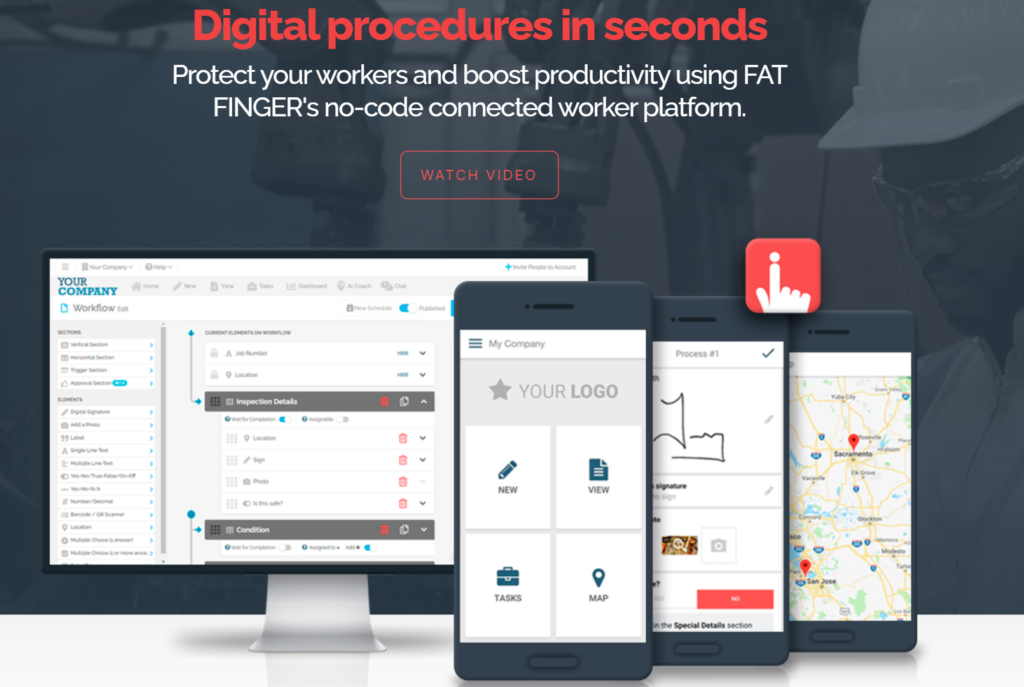Asset inspection is a critical component of maintaining operational efficiency and safety in various industries. As technology advances, so do the methods and techniques used in asset inspection. This article delves into the future trends in asset inspection procedures and techniques, providing valuable insights and examples. We will also explore how digital workflows, such as those offered by FAT FINGER, can revolutionize asset inspection processes. Request a demo today to see how FAT FINGER can enhance your asset inspection procedures.
The Evolution of Asset Inspection
Asset inspection has come a long way from manual checklists and paper-based records. The evolution of asset inspection can be categorized into three main phases:
- Manual Inspections: Traditional methods involving physical checklists and manual data entry.
- Digital Inspections: The introduction of digital tools and software to streamline data collection and reporting.
- Automated Inspections: The use of advanced technologies such as drones, IoT devices, and AI to automate inspection processes.
As we move forward, the focus is on enhancing efficiency, accuracy, and safety through innovative technologies.

Emerging Technologies in Asset Inspection
Several emerging technologies are set to transform asset inspection procedures. These technologies not only improve the accuracy of inspections but also reduce the time and cost involved. Let’s explore some of these technologies:
1. Drones and Unmanned Aerial Vehicles (UAVs)
Drones and UAVs are becoming increasingly popular in asset inspection, especially in industries such as oil and gas, power generation, and infrastructure. They offer several advantages:
- Access to Hard-to-Reach Areas: Drones can easily access areas that are difficult or dangerous for human inspectors.
- High-Resolution Imaging: Equipped with high-resolution cameras, drones can capture detailed images and videos for analysis.
- Cost-Effective: Drones reduce the need for scaffolding, cranes, and other expensive equipment.
For example, a case study by the American Society of Mechanical Engineers (ASME) highlighted how a power company reduced inspection time by 75% using drones.
2. Internet of Things (IoT)
The Internet of Things (IoT) is revolutionizing asset inspection by enabling real-time monitoring and data collection. IoT devices can be installed on assets to continuously monitor their condition and performance. Key benefits include:
- Real-Time Data: IoT devices provide real-time data, allowing for immediate detection of issues.
- Predictive Maintenance: By analyzing data trends, IoT can predict potential failures and schedule maintenance proactively.
- Reduced Downtime: Early detection and predictive maintenance reduce unplanned downtime and extend asset life.
A study by McKinsey & Company found that IoT-enabled predictive maintenance can reduce maintenance costs by up to 25% and unplanned outages by up to 50%.
3. Artificial Intelligence (AI) and Machine Learning (ML)
AI and ML are transforming asset inspection by automating data analysis and decision-making processes. These technologies offer several advantages:
- Automated Data Analysis: AI algorithms can analyze large volumes of data quickly and accurately.
- Anomaly Detection: ML models can identify patterns and detect anomalies that may indicate potential issues.
- Improved Accuracy: AI reduces human error and improves the accuracy of inspections.
For instance, a case study by IBM demonstrated how AI-powered inspection systems reduced inspection time by 30% and improved defect detection rates by 20%.
The Role of Digital Workflows in Asset Inspection
Digital workflows are essential for streamlining asset inspection processes and ensuring consistency and accuracy. FAT FINGER offers a robust digital workflow solution that addresses common pain points in asset inspection. Let’s explore how FAT FINGER can enhance your asset inspection procedures:

1. Streamlined Data Collection
Manual data collection is time-consuming and prone to errors. FAT FINGER’s digital workflows enable seamless data collection using mobile devices. Key features include:
- Mobile Accessibility: Inspectors can use smartphones or tablets to collect data in the field.
- Real-Time Syncing: Data is synced in real-time, ensuring that all stakeholders have access to the latest information.
- Customizable Forms: Create custom inspection forms tailored to your specific needs.
2. Enhanced Data Analysis
Analyzing inspection data manually can be overwhelming. FAT FINGER’s digital workflows offer advanced data analysis capabilities:
- Automated Reports: Generate detailed reports automatically, saving time and effort.
- Data Visualization: Visualize data trends and patterns using charts and graphs.
- Integration with AI: Integrate with AI tools for advanced data analysis and anomaly detection.
3. Improved Compliance and Documentation
Maintaining compliance with industry regulations is crucial. FAT FINGER ensures that all inspection procedures are documented and compliant:
- Audit Trails: Maintain a complete audit trail of all inspections and actions taken.
- Regulatory Compliance: Ensure compliance with industry standards and regulations.
- Secure Data Storage: Store data securely in the cloud, with easy access for audits and reviews.
Conclusion: The Future of Asset Inspection
As we look towards the future of asset inspection procedures and techniques, it is evident that technological advancements will play a pivotal role in shaping this field. As these technologies evolve, we can anticipate a significant shift towards more proactive and data-driven inspection strategies, ultimately enhancing the reliability and safety of critical infrastructure across various industries.
Tired of manual inefficient processes? Build your asset inspection checklist for free now, or request a demo.

